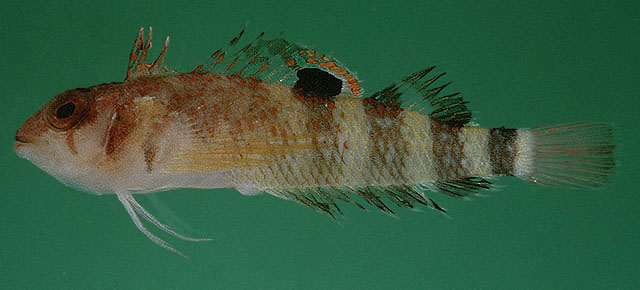| Tripterygiidae (Triplefin blennies), subfamily: Tripterygiinae |
| 3.1 cm TL (male/unsexed); 2.66 cm SL (female) |
|
demersal; marine; depth range 3 - 9 m |
| Western Indian Ocean: Arabian Sea, Oman. |
|
Dorsal spines (total): 15-15; Dorsal soft rays (total): 10-10; Anal spines: 1-1; Anal soft rays: 18-18. Pectoral-fin rays 15-16, at least some branched; body whitish with 6 distinct vertical orange-brown bars (live color) or dusky bands (color in alcohol), becoming progressively darker posteriorly, the darkest across the caudal peduncle; caudal peduncle bar broad and continuous, encircling the peduncle; with white band at base of caudal fin; anal fin whitish with 4 broad dusky zones; pored lateral-line scales 14-15; anal fin rays 18; second dorsal fin with black spot basally, capped by a bright orange arc in life. |
| Adults are found on rocky or rubble bottom. Stomach and gut contents reveal pycnogonid, ostracods, copepods, and isopods (Ref. 12476). Eggs are hemispherical and covered with numerous sticky threads that anchor them in the algae on the nesting sites (Ref. 240). Larvae are planktonic which occur primarily in shallow, nearshore waters (Ref. 94114). |
|
Least Concern (LC); Date assessed: 03 May 2010 Ref. (130435)
|
| harmless |
|
Source and more info: www.fishbase.org. For personal, classroom, and other internal use only. Not for publication.

